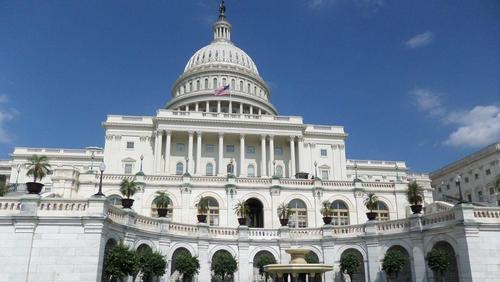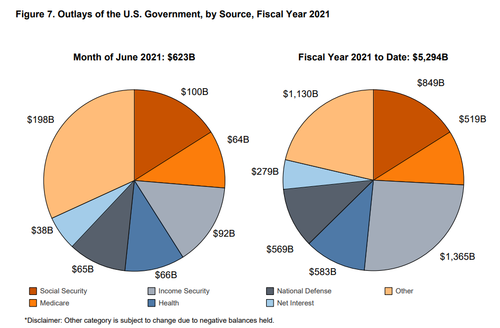Schiff: US Government Spending Sure Isn’t Transitory
The mainstream narrative is that the Fed will soon admit that inflation isn’t transitory. At that point, it will raise interest rates and taper its bond-buying program to fight rising prices. But this narrative ignores the elephant in the room – the ever-increasing national debt.
In June, the US government ran another big deficit of $174.16 billion, continuing the trend of overspending and massive budget shortfalls.
With three months remaining in fiscal 2021, the budget deficit stands at a staggering $2.24 trillion, according to June Monthly Treasury Statement.
Despite the fact that the economy has opened back up, the US government continues to run massive budget deficits month after month after month.
Uncle Sam spent $623 billion in June, a 4.3% increase over May’s outlays. That’s over half a trillion dollars in federal spending in just one month. Total spending for fiscal 2021 now stands at $5.29 trillion. Spending is up 6% in fiscal 2021 compared to the same period last year.
The Treasury received $449 billion in June. Treasury receipts were bolstered by the late tax filing deadline this year.
As of July 12, the national debt stood at $28.49 trillion.
According to the National Debt Clock, the debt to GDP ratio is 128.23%. Despite the lack of concern in the mainstream, debt has consequences. More government debt means less economic growth. Studies have shown that a debt to GDP ratio of over 90% retards economic growth by about 30%. This throws cold water on the conventional “spend now, worry about the debt later” mantra, along with the frequent claim that “we can grow ourselves out of the debt” now popular on both sides of the aisle in DC.
There is no sign that the federal government plans to rein in spending any time soon. Congress continues to wrangle over an infrastructure deal with a $2 trillion price tag. President Biden has also pitched “free” community college and childcare. This all piles on top of the $6 trillion in spending packed into the proposed 2022 budget. Biden has pitched a number of corporate and individual tax increases to pay for the spending, but he’s already had to back off on some of the taxes due to political pressure. That means most of this borrowing and spending will continue to be paid for through an inflation tax that will hit us as the Federal Reserve monetizes this massive debt. That means more bond purchases and more money printing.
And this raises the $64,000 question:
How will the Fed raise rates and taper bond purchases when the US government has to continue borrowing money?
How can an economy built on borrowing and spending function if interest rates rise?
Simply put — it can’t.
The fact is that given all of the debt the US economy can’t handle the high interest rate environment necessary to tame rising prices. The Federal Reserve boosted interest rates modestly to 2.5% in 2018 and all hell broke loose. The stock market crashed, and the Fed was forced back to loose monetary policy even before the coronavirus pandemic. As Schiff noted in a podcast, if the economy couldn’t handle higher rates in 2018, it certainly can’t handle them today.
The level of debt is so much greater than it was then. And so, the more debt you have, the lower interest rate is required to be able to service that debt. So, if two-and-a-half percent was too much when the national debt was significantly lower than it is today, then that threshold is much lower. I don’t even think we could survive a move to one percent from the Fed.”
It seems almost certain the massive budget deficits will continue into the foreseeable future. That means the government will need to continue borrowing and it will need the central bank to keep its thumb on the bond market to make that possible. That means no tightening.
You can find a more in-depth breakdown of the deficit HERE.
Tyler Durden
Wed, 07/14/2021 – 13:24

